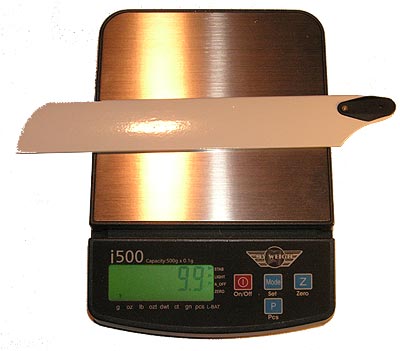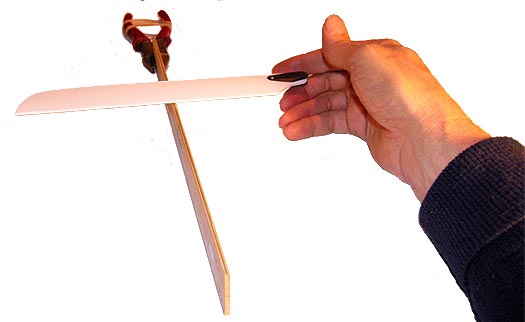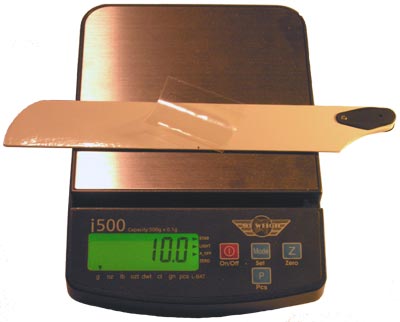Balancing the Main Blades
Balance the main rotor blades to make your helicopter fly smoothly. When you first get a helicopter, and every time you install new blades, you want to check them to see if they are balanced and balance them if they are not. There are two ways to do this.
Blade Balancing Method 1
Put a long bolt through the hole in each main blade's root and secure it (not too tightly) with two nuts and two washers so the two blades can be positioned in the middle of the bolt. There are also ready-made blade balancers available like the one pictured below from Align Corporation. You want to arrange the blades so they face the way they go on a helicopter.
 |
Blade balancing tool |
Now rest the ends of the bolt on two blocks and observe the blades. If they are equal in weight they will not rotate when you put them in a horizontal position. If one blade sinks you need to put tape on the oppoosite one until they rest horizontally. In this method you must deteermine how much tape to use by trial and error.
 |
Main blades held by balancer rested on plastic boxes. Right blade is a little heavy. |
This is the down-and-dirty way to balance the main blades. The next method describes how serious helicopter nuts balance their blades.
Blade Balancing Method 2
SSG_Scott on RCgroups.com was working on real helicopters in the military when he told us how main rotor blades are balanced on the real thing. Scott said that not only must the blades weigh the same, they should also have the same center of gravity (CG). For accuracy and ease of procedure the best way to balance your blades is on a digital scale that is accurate to one-tenth of a gram like the one shown below. The first step is to weigh both blades:
 |
This is the lighter blade. The heavier one weighs exactly 10 grams. |
Take the heavier blade and determine its center of gravity. Put a ruler with a steel straightedge on its edge and balance the blade on it. You can put a rubber band around the handles of a pair of pliers to make a vise to hold the ruler in the right position.
 |
Finding the center of gravity of the heavier blade. |
Mark the balance point with a sharpie. Then put the two blades together against a firm object so they line up and transfer the mark to the same position on the lighter blade.
Put the ligher blade back on the scale and cut a piece of clear packing tape that weighs the same as the difference between the blades. The tape in the next picture weighs one-tenth of a gram. When the lighter blade and piece of tape weigh the same as the heavier blade you are ready for the last step.
 |
Lighter blade + tape = 10 grams. |
Put the lighter blade on the straight edge at the CG mark that you transfered from the heavier blade. (Note the sharpie mark on the blade below the tape.) Move the piece of tape until the blade balances right on the mark. Apply the tape at that position so it wraps around the leading edge of the blade. No tape edge should face the blade's direction of travel. Now both blades weigh the same and have the same center of gravity.